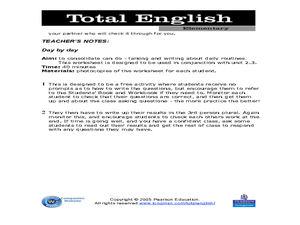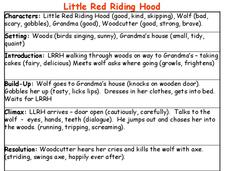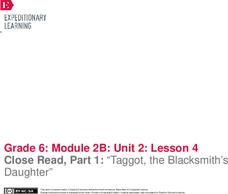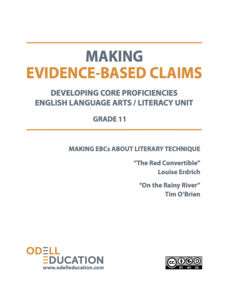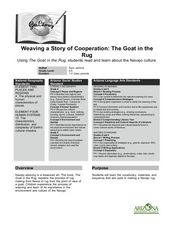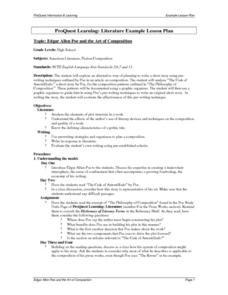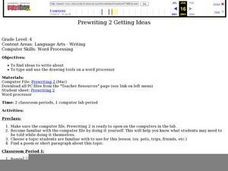Curated OER
Total English Elementary: Day by Day
In this talking and writing about daily routines instructional activity, learners record information on the graphic organizer, interview other students about their daily routines, and write sentences to describe the answers each student...
Institute for the Professional Development of Adult Educators
Using Context Clues with Signal Words
When you come across an unfamiliar word in a text, do you skip it and move on? Practice using context clues to identify words you don't know with a thorough set of language arts lessons. The resource reinforces close reading and critical...
Curated OER
Setting Worksheet
Set your class up for success with writing descriptive settings with these two graphic organizers. On the first page, writers note specifc details about their chosen setting and comment on how each character views the setting. The second...
Curated OER
Multiplication Stories
Learners practice multiplication using fill in the blank graphic organizers. For this multiplication lesson plan, students create multiplication stories using the given prompts. The storied can be placed in a book when the learners...
Curated OER
Little Red Riding Hood
Here is a short, but effective, four-slide presentation on the sequence of events in the story, Little Red Riding Hood. The elements of the story (setting, characters, plot, etc.) are present, then a slide which puts the story in order...
EngageNY
Mid-Unit Assessment: Analyzing a New Narrative about a Natural Disaster, Part II
See it through my eyes. Scholars complete mid-unit assessment part II by writing an essay describing how the narrator's point of view influences how the story is told in the text In the Middle of the Storm. Pupils also complete a...
Curated OER
Character Analysis Chart
This versatile graphic organizer could be used alongside any novel, poem, play, or story through which your class in studying character. Class members can get characters straight or describe particular characters in more detail with this...
Curated OER
Characterization Worksheet
Use any story with this characterization worksheet! On the first page is a graphic organizer that encourages the reader to look for examples of direct characterization. On page two, read about direct and indirect characterizations,...
Noyce Foundation
Apple Farm Field Trip
Monitor the growth of young mathematicians with a comprehensive addition and subtraction assessment. Using the context of a class field trip to an apple orchard, this series of four story problems allows children to demonstrate their...
EngageNY
Notices and Wonders of the Second Stanza of “If”
Here is an instructional activity that asks pupils to analyze poetry and sparks discussion about two different types of texts: asking how is the poem, If by Rudyard Kipling alike and different from the story, Bud, Not Buddy by...
Annenberg Foundation
America's History in the Making: Classroom Applications Four
The final installment of a 22-part American history series examines the many faces that make up the country's story. From Henry Ford to Tulio Serrano, scholars use biographical evidence and Internet research to uncover the people behind...
EngageNY
Analyzing How Shakespeare’s Play Draws upon Greek Mythology: Part 2
Pupils explore the narrative structure of a piece of literary text, mapping out the plot structure of the Greek myth "Pyramus and Thisbe." Next, they use their completed graphic organizers to write story summaries.
McGraw Hill
Study Guide for Frankenstein
Help the class uncover the story of Frankenstein. Learners answer questions and complete activities to respond to the text Frankenstein as they read. Scholars learn new vocabulary, respond to personal and text-dependent questions,...
EngageNY
Building Background Knowledge About the Hero’s Journey, Part 2: Acts 2 and 3 Plus Focusing on Key Vocabulary in “The Hero’s Journey”
It's all in the details. Scholars read acts two and three of The Hero's Journey and collect important details from the text. They share their notes with their peers and listen for key words from the story. They then turn their attention...
EngageNY
Close Read, Part 1: “Taggot, the Blacksmith’s Daughter”
There would be no luck if it were not for bad luck. Scholars take a close look at the theme of adversity through multiple reads of Taggot, the Blacksmith’s Daughter. They place sticky notes on important details of the story and complete...
K20 LEARN
We've Got Character! Literary Analysis: Characterization
How authors bring characters to life and make them believable is the focus of a activity on characterization. Readers closely examine passages from To Kill a Mockingbird and Dreamland Burning, noting details that reveal the character's...
Curated OER
The Glass Menagerie by Tennessee Williams
Provided here is a packet of worksheets to accompany The Glass Menagerie by Tennessee Williams. To start, readers research words commonly associated with the time period. Then, a list of 30 tough vocabulary words are listed (including...
Odell Education
Making Evidence-Based Claims Literary Technique: Louise Erdrich and Tim O’Brien
Take a ride in The Red Convertible by Louise Erdrich. Students read the story and discuss whether a car is really a character. After carrying out several activities using graphic organizers and tools for making their claims in The Red...
Curated OER
Weaving a Story of Cooperation: The Goat in the Rug
Weaving is an important part of Navajo culture. Read The Goat in the Rug to your fourth and fifth graders, and give them a glimpse into the process of rug making from the point of view of a goat! They will learn new vocabulary words and...
Curated OER
Edgar Allen Poe And The Art Of Composition
High schoolers evaluate several works by Edgar Allen Poe based on the criteria in his essay, "The Philosophy of Composotion" Their analysis is documented using a graphic organizer. Learners begin the pre-writing process for their own...
Curated OER
Some Days Are Like That!
Second graders engage in an activity of reading a story and have a discussion about the story to measure comprehension. The use of a graphic organizer helps student retention because it is brain compatible for students.
Curated OER
Build Mastery: Main Idea
Use a graphic organizer to get readers thinking about main ideas as they record the who, what, where, when, and why of a story. Consider modeling this process completely before kids do this independently. They fill in five boxes charting...
Curated OER
Prewriting 2 Getting Ideas
Fourth graders read a poem or short paragraph and have students picture it in their minds. They relate the topic to something in their experience and illustrate, 4th graders generate questions with a graphic organizer, use Prewriting2...
Curated OER
Fairy Tales
Students listen as the teacher reads fairy tales to students and identify patterns. They listen as the teacher re-reads the fairy tales and signal or recite patterns as they listen. Students identify patterns in the fairy tales. They...
